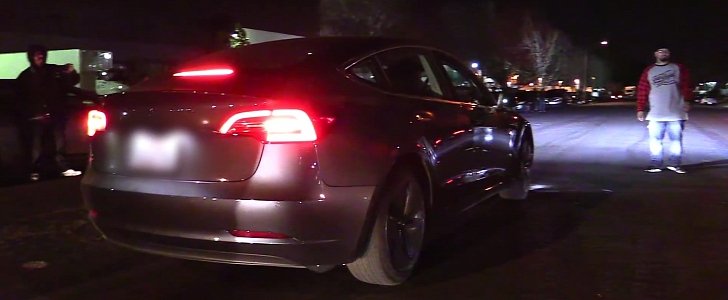With a few months of deliveries under its belt already - though lacking any impressive numbers - the talk around the Model 3 is finally starting to head toward those areas where everybody hoped it would ever since Musk made the announcement about the smaller electric sedan.
Yes, we're talking about acceleration, power output, quarter-mile performance, and all that. We've seen the 3 in an untimed, unofficial - and probably illegal - drag race against a Pontiac G8 GT which it won, and we also saw it up on the dyno for an exact evaluation of its motor.
The latter revealed the Model 3 has ridiculous amounts of torque - 552 lb-ft (nearly 750 Nm), to be exact - and decent power output - around 330 hp, all obtained from the single motor sat over its rear axle. In the end, the Model 3 will have two more versions that will offer even better performance.
The first way to improve it is to add another motor. If the Model S template will be replicated, that means a smaller unit with less hp powering the front wheels. The second one will build on the dual-motor setup, using software tinkering to increase the output and bring the sedan to its maximum level of performance.
With Tesla scrambling for cash at the moment, at least the first of these upgrades is expected to roll-out shortly, bumping the average price of Model 3s ordered from the current ~$50,000 to probably over $60,000, thus increasing the company's profit.
In the meantime, a Tesla owner called "Ingineerix" that's quite adept at hacking of the software variety has gotten hold of his Model 3. Not the type to waste time, he immediately started inspecting the EV on all sides, including the inner workings of its silicon chips.
One of his stunts involved accessing the vehicle's "Factory Mode," a diagnostic tool used by Tesla engineers to make sure everything is alright with the car - or find out where the problem is, depending on the situation.
Among other things, a screen capture (via electrek) of his meddling with the Model 3's software reveals a maximum discharge rate off 1,200A, which is surprisingly high given the EV's relatively small battery pack. What this tells us is that the two motors on the upcoming versions are going to be able to suck up the electrons quickly enough to deliver a high power output.
By comparison, the Model S P100D, with its 100 kWh battery pack, only offers about 100A more, and we all know how that goes on a drag strip. Tesla's packs are notorious for their conservative discharge rates, which is why a lot of custom projects - like the Teslonda - source them from Chevrolet Volts. The Model 3 seems to bring things up a notch compared to the larger Model S, though nothing spectacular. Even so, the tension surrounding the go-faster Model 3 is starting to build up.
The latter revealed the Model 3 has ridiculous amounts of torque - 552 lb-ft (nearly 750 Nm), to be exact - and decent power output - around 330 hp, all obtained from the single motor sat over its rear axle. In the end, the Model 3 will have two more versions that will offer even better performance.
The first way to improve it is to add another motor. If the Model S template will be replicated, that means a smaller unit with less hp powering the front wheels. The second one will build on the dual-motor setup, using software tinkering to increase the output and bring the sedan to its maximum level of performance.
With Tesla scrambling for cash at the moment, at least the first of these upgrades is expected to roll-out shortly, bumping the average price of Model 3s ordered from the current ~$50,000 to probably over $60,000, thus increasing the company's profit.
In the meantime, a Tesla owner called "Ingineerix" that's quite adept at hacking of the software variety has gotten hold of his Model 3. Not the type to waste time, he immediately started inspecting the EV on all sides, including the inner workings of its silicon chips.
One of his stunts involved accessing the vehicle's "Factory Mode," a diagnostic tool used by Tesla engineers to make sure everything is alright with the car - or find out where the problem is, depending on the situation.
Among other things, a screen capture (via electrek) of his meddling with the Model 3's software reveals a maximum discharge rate off 1,200A, which is surprisingly high given the EV's relatively small battery pack. What this tells us is that the two motors on the upcoming versions are going to be able to suck up the electrons quickly enough to deliver a high power output.
By comparison, the Model S P100D, with its 100 kWh battery pack, only offers about 100A more, and we all know how that goes on a drag strip. Tesla's packs are notorious for their conservative discharge rates, which is why a lot of custom projects - like the Teslonda - source them from Chevrolet Volts. The Model 3 seems to bring things up a notch compared to the larger Model S, though nothing spectacular. Even so, the tension surrounding the go-faster Model 3 is starting to build up.

